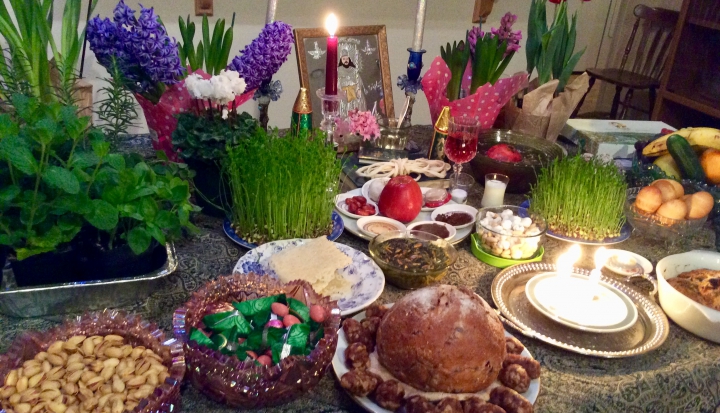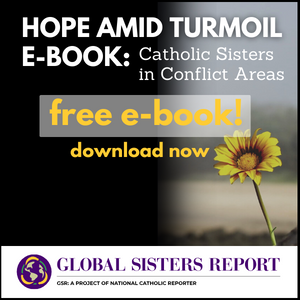I observe two new year celebrations in three months. First, I celebrate New Year’s Day on January 1. Every year, I watch the ball drop at midnight on television, sing “Auld Lang Syne” with family and friends, and sleep in late the next day after celebrating the night before.
But the big new year celebration for me occurs near the end of March. At the exact moment of the vernal equinox in the northern hemisphere, I celebrate Nowruz, the Persian new year, which has been observed for more than 3,000 years by Iranians and other ethno-linguistic groups. This year, the holiday started on Tuesday, March 20 at 12:15 p.m. EST.
Today approximately 300 million people celebrate this ancient holiday that predates Abrahamic religions. Although it is considered a holy day in Zoroastrianism, the Bahá’í faith and other religions, Nowruz is officially a secular holiday in Iran and other countries. Festivities continue for 13 days in Iran. On the last day, Sizdebedar, families spend time picnicking outdoors and enjoying nature, signaling the end of the Nowruz season.
Nowruz, literally meaning “new day” in Farsi, is rich in traditions centering around the new beginnings associated with spring, the season of new life. One tradition is a deep spring cleaning before the new year, known in Farsi as khooneh tekouni, or “shaking the house.” Families decorate their clean homes with greenery and fresh flowers; hyacinths, tulips, and pussy willows are especially popular.
For me, a half-Iranian Catholic, it’s a perfect way to transition into the Easter season. Like celebrating rebirth and reinvigoration upon spring’s arrival for Nowruz, Easter is about celebrating the Christ’s resurrection—his new life. Nowruz may even have inspired some of Easter’s traditions, including egg decorating as a symbol of new life.
The Nowruz food also helps remind me of Lent: Three traditional Nowruz dishes are sabzi polo mahi (herbed rice with fish), ash-e reshteh (thick noodle soup) and kuku sabzi (egg dish made with herbs and leafy green vegetables). They are wonderful dishes to enjoy during gatherings, yet simple and humble meals that can be eaten during Lenten Fridays.
The parallels don’t stop there: Chaharshanbe Suri is a beloved Iranian festival celebrated the last Tuesday evening before Nowruz. During Chaharshanbe Suri, participants chant, “Zardi-ye man az toh, sorkhi-ye toh az man,” while jumping over a bonfire three times. The chant is Farsi for “My yellow is yours, your red is mine,” meaning jumpers are giving away their yellow pallor, sickness, and problems to the fire, receiving the fire’s energy and warmth in return. Members of the Armenian Catholic Church observe a similar tradition in a feast of purification called Trndez, commemorating the 40 days after Jesus’ birth.
A home’s centerpiece during Nowruz is the haft-seen, a tabletop decorated with seven symbolic items that start with the Persian letter seen; haft-seen literally means “seven seens” in Farsi. The seven haft-seen items include:
Sabzi: Green sprouts growing from a dish that symbolize greenery, nature, and the rejuvenation of life
Samanu: Sweet germinated wheat pudding, which symbolizes affluence, bravery, and power
Seeb: Apple to represent health and beauty
Seer: Garlic to symbolize health and medicine
Senjed: Dried Persian olive fruit to represent love
Serkeh: Vinegar to symbolize age and patience
Somagh: Sumac, which represents the color of the sunrise
A haft-seen doesn’t need to be fancy or large—I have made mine from a folding tray table in my small apartment—and they are individually decorated according to personal tastes, although the “seven seens” are always there.
Other items commonly placed on a haft-seen include a mirror to represent self-reflection, a bowl of water with live goldfish, fresh flowers, candles for enlightenment, coins for wealth and prosperity, decorated eggs for fertility, and a holy book and/or poetry, usually the works of Persian poet Hafez. I include a Bible and sheets of liturgical music affiliated with Lent and Easter on my haft-seen.
Families and friends typically gather around the haft-seen for the saal tahvil, Farsi for the northern hemisphere’s vernal equinox and the precise starting moment of the new year. It is also customary to throw the sabzi grown for the haft-seen into running water during Sizdebedar.
I have to remind myself each year that while I am actively participating in the 13 days of Nowruz festivities, I am simultaneously observing Lent, the most solemn time in the Catholic liturgical calendar. Before Christ resurrected, he died and was buried for our sins. While Christ wants—and encourages—us to engage in fellowship with family, friends, and neighbors, I remain mindful of his journey into the desert for 40 days while I spend time with fellow Nowruz observers.
Although Nowruz is Iran’s most important national holiday, it can be celebrated and cherished by anyone regardless of cultural background, ethnicity, or religion. In 2016, UNESCO added Nowruz to its Intangible Cultural Heritage list and officially declared March 21 International Nowruz Day. Every U.S. president since George H. W. Bush has delivered an annual Nowruz greeting, and former First Lady Michelle Obama hosted Nowruz celebrations at the White House, complete with a haft-seen. The prime minister of Canada also delivers an annual Nowruz Message. The U.S. House of Representatives and Parliament of Canada have both passed legislation recognizing Nowruz for its cultural and historical significance.
My Catholic Nicaraguan mother also enjoys celebrating Nowruz. Whenever my father was in Iran during Nowruz in years past, she would reach out to our Iranian friends to join the festivities. Even my rosary-clutching abuelita loves to celebrate Nowruz with us when she’s in town.
This year will be the first time I celebrate Nowruz with family and friends since I graduated from high school nine years ago. The house is clean, the lentils are sprouting, herbs have been chopped, bonfires have been jumped over, and I ended Nowruz preparations with a Bible study with fellow Iranian Christians. This Easter is going to be even more joyful for me.
Image: Sima Mazdai











